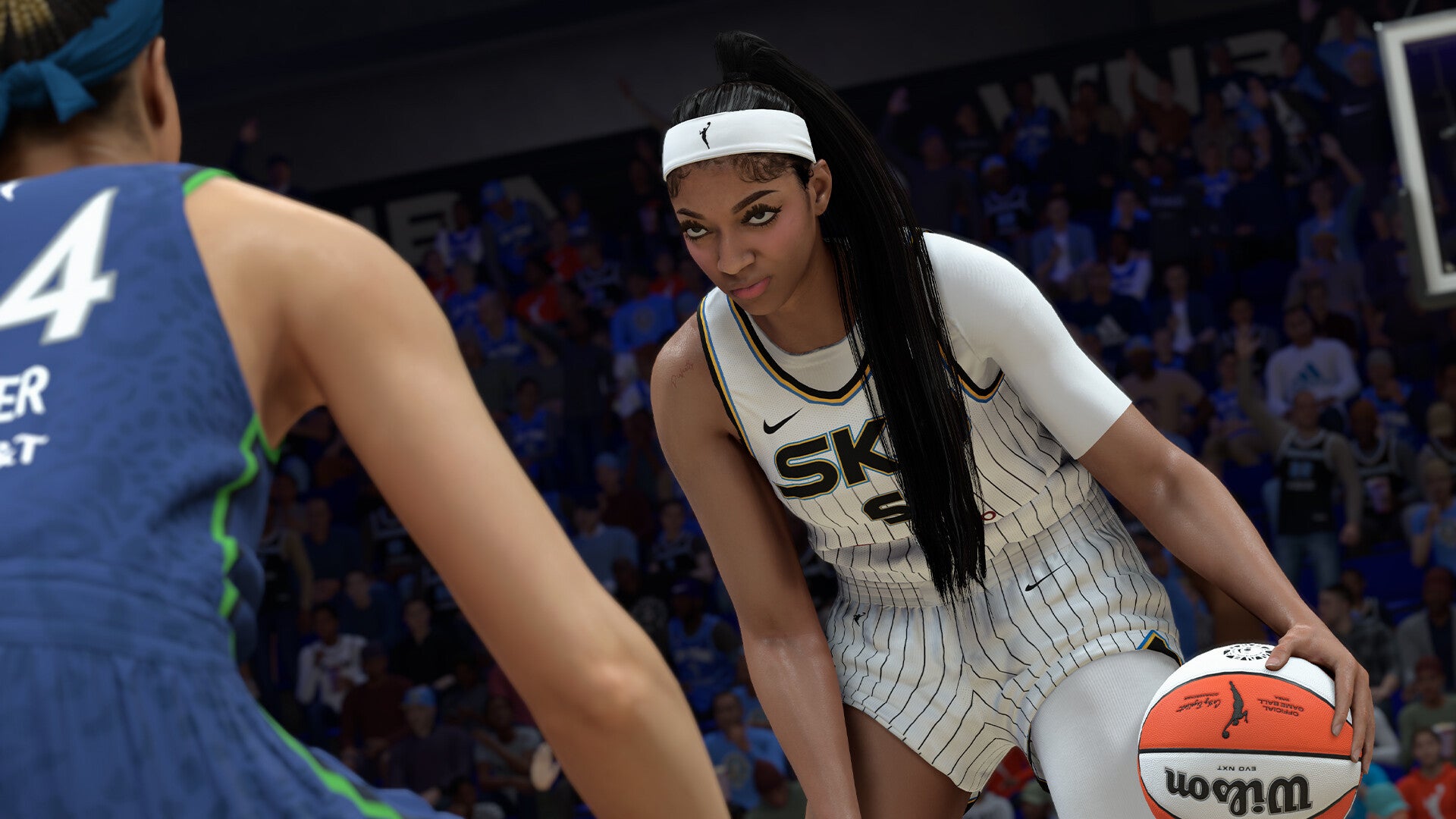
I regularly go against my best consumer instincts and check out the yearly iterations of sports games. It’s not something I’d likely be doing without some Steam press account magic letting me dodge the yearly cash sacrifice for a game that usually shares a huge chunk of DNA with its direct predecessor; a sense of deja vu is inevitable, unless you’ve been sensible enough to either let a few years pass or wait until you’ve spotted a new feature that piques your interest.
With NBA 2K26, there was one such addition in my mind. As someone who’s been keen to see 2K’s ball-to-basket series get rid of the invisible wall it’d put up between its simulations of men’s and women’s basketball for a good few years, the first-time addition of WNBA players to one of the marquee male-dominted modes caught my attention. Granted, it was MyTeam, the depressing pit in which you fork over either real money or fake money - acquired across hours of grinding - to buy trading cards that may or may not be dished out via something resembling a slot machine.
I wouldn’t be deterred from at least giving it a go, though. Given the nature of basketball, with its emphasis on height dictating different playstyles and requirement for close-knit teamwork, I figured mixing WNBA ballers in with NBA giants might make for a more unique contrast in experience than, say, playing with a mixed team in EA Sports FC.
In practice, I wasn’t disappointed. I opted for a starter pack that gave me the entire lineup of the WNBA’s Seattle Storm, then built it out with some extra cards and short-term high overall loanees that leant more female than male, making sure I retained some lads to work into my lineup.
Over the course of some breakout and triple threat park matches, most of which have minimal margin for error despite their less formal trappings, I’ve found getting the right mix of baller genders to be satisfyingly difficult. Naturally, the average NBA squad has a height advantage in any matchup, which can make securing rebounds and scoring close to the basket a very tall order for an all-WNBA squad. So, you’ve got to lean into skill and speed, either by finding ways to quickly streak to the rim in transition (or after breaking a defender’s ankles), or relying on your shots from distance.
In terms of the former, I’ve had a lot of fun with Jordin Canada, whose relentless pace and great handles make her feel like a five foot six Allen Iverson. For threes, I’ve taken to relying on Kayla McBride, while the best all-round package I’ve found has been an 89-rated Kelsey Plum, who excels in both of those areas. In terms of a trios squad, teaming up Plum and McBride with the 85-rated Moses Malone (who you get in the tutorial) made for some fun wins, with the retro big man’s inside defensive presence and rebounding prowess helping balance out the areas that even taller WNBA players like Angel Reese tend to struggle in.
Image credit: 2K / Rock Paper ShotgunDisappointingly, I’ve found that the teams I’ve gone up against - whether AI or player-controlled - tend to still be mainly blokes. With CPU-controlled opponents, I figure it might be down to a WNBA-heavy squad potentially being an easy win if someone’s decided to play with three forwards or centers, so that’s something devs Visual Concepts will need to address going forwards.
In terms of the on-court action, part of what made those games a blast are the tweaks 2K26 makes to the shooting, rebounding, and movement. I’ve got a more mixed view on the former, which is literally hit or miss. Getting a perfect release, which has been signified by the meter turning green for a good few years now, appears to be easier in a number of 2K26’s modes. Which is a good thing, because the chances of making the shot if you don’t release right on cue seem to have been drastically nerfed. The result is that you get to go on immensely satisfying runs when your shots are dropping, but being on the other side of that and trying to grind out points sometimes feels impossible. Get into a park match against someone who’s got their jumper timings down to a T and has players who aren’t easy to block? You might as well not try on defense.
Going up against the AI makes that less of a concern, and it’s in MyPlayer mode where the game really start to sing. I opted to play as a center, the tallest and slowest player on the court who generally spends most of their time getting physical near the basket. The lingering annoyance of your rookie player starting off as a useless lump that’s a bore to control is still there. They can only be upgraded using the virtual currency, which feels deliberately grindy, and can also be bought using real money because of course it can.
Image credit: 2K / Rock Paper ShotgunOnce I’d managed to get a decent baseline, though, I was flying through the air to catch rebounds, employing the new timing meter to ensure I lept at just the right moment. The jostling under the rim feels nice and weighty, and close-range scoring via layups and post moves now seems as effective if you’re keen to more than a pure slamdunk merchant. What Visual Concepts have dubbed their "MyPlayer Freelance Engine" has also vastly improved your AI teammates' off-the-ball intelligence, making them much better at picking you out with passes at the right time - without you having to grind the offense to a halt every time via repeated calls for the ball.
This brings me to the narrative of this year’s MyPlayer mode, dubbed Out of Bounds. These are relatively simple, often cliche-heavy tales simply designed to put a bit of story meat on the bones of your created baller’s short journey from nobody to NBA hero. Out of Bounds certainly doesn’t disappoint in that regard. With college basketball now back on the map in terms of standalone games thanks to its athletes finally being paid for the use of their names, images, and likenesses, 2K’s NBA game has had to dip back into the bin of royalty-free routes to stardom. As such, after playing a couple of high school games in remote Vermont, 2K26’s MyPlayer jets off to Los Angeles to take part in a club league that’s treated like university ball’s more casual cousin.
To be fair, a single four-game season there isn’t the be-all-and-end-all, with a trip to Europe on the cards as you aim to up your draft stock. Ooh, thought I, 2K have included teams from real-world European basketball leagues in the past, are those back? Sadly not. Instead, you’re suiting up for mirror universe Real Madrid and rubbing shoulders with yet more created players. There are at least nice establishing shots of cities like Malaga and Madrid to make things feel a tiny bit more real. 80% of your player’s dialogue is boasting or pouting, to the point where they feel genuinely unlikeable at certain points, though that’s to be expected. Oh, and the Madrid season’s storyline is mostly based around you earning the approval of a Slovenian teammate whose personality and mannerisms have been shamelessly ripped from GTA IV.
Image credit: 2K / Rock Paper ShotgunHaving had enough of shooting guard Roman Bellic, you may well bolt for 2K26’s array of management modes. Understandable - I've spent much of my time with previous NBA games' equivalents, if only for a reprieve from constantly being advertised at. This time, though, I'll save you some trouble: don't bother. Whether it’s MyGM, MyWNBA, or the MyNBA Eras mode that’s essentially been my only excuse for playing more than 30 hours of these games over the past half decade, you’ll be disappointed in how little they've progressed.
There are a couple of minor changes. Some new GM scenarios to start from and more of a structure to yearly owner goals. A new expansion team in the form of the Golden State Valkyries. The option to make your Eras sim run slower, but purportedly smarter, or to speed things up and sacrifice some depth of computer thought. The first two are ok, but hardly worthy headliners.
The last one, meanwhile, genuinely seems to have changed almost nothing. Teams with an abundance of players at one position will still trade for, draft, and sign more players at that position without offloading one of their established crop to get better elsewhere. Offseasons still end with very good players left unsigned because computer teams haven’t managed to manage their cap room effectively, making them very easy to pick up on cheap one-year deals once the season kicks off.
That seems particularly problematic when it comes to WNBA sims, with a lot of star players being on short-term deals, meaning plenty of talent can be left on the table amid the bidding wars - then signed for pennies. Computer-made trade proposals do seem a tad more logical this time around, but I still saw instances of teams pulling questionable moves, like trading multiple future first-round picks for one mid-round pick during drafts.
Oh, and you can still phase through your staff in MyGM mode. | Image credit: 2K / Rock Paper ShotgunAll in all, it’s the usual fridge full of good and bad ingredients, making for a soup that tastes slightly different to last year’s - but not noticeably superior. As such, unless there's a specific change you like the sound of, 2K26 is probably a year to skip. It’s best summed up by its version of The City - the explorable hub where MyPlayers wander around and join impromptu street games. Rather than 2K25’s ridiculously extravagant urban sprawl, complete with pirate ship area, mech workshop and Michael Jordan-themed coliseum, this time, almost everything is tightly packed into a nondescript shopping centre and park.
Am I going against my instincts by preferring when this basketball game had a huge pirate ship, which was likely at least partially responsible for 2K25 taking up about 50GB more hard drive space than the still-almost-100GB 2K26? Almost certainly, yes, but that’s what reviewing yearly sportsathons can do to a guy.













